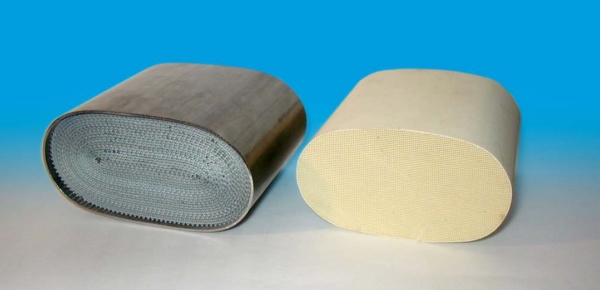A catalytic converter is a device that can remove polluting substances contained in the exhaust gases of internal combustion engines. It is not a filter, but a chemical reactor, where conversion reactions happen, between the precious metals it contains and the exhaust gas.
The duration of the converter depends on the quantity of precious metals, while its efficiency depends on the way they are distributed inside the substrate. At BRAIN, we use high-quality, Euro 4-certified monoliths with a warranty of 36 months.
In order for the reactions to happen, the catalytic converter needs to reach a temperature of 400°C as quickly as possible. Such a rapid increase of temperature will cause thermal, chemical and mechanical stress to the substrate, which is why it has to be built with a light and non-bulky material, that allows for large surfaces.
With this respect, a metallic substrate has several advantages over a ceramic one:
- Better heat conductivity
- Quicker to heat-up (light-off time)
- Reduced risk of overheating
- Reduced thickness of the substrate walls (0.03mm, as opposed to 0.1mm in the ceramic substrates)
- Larger surface of use
- Wider choice of cells density (between 25 and 1200 CPSI, as opposed to 400 CPSI in ceramic substrates)
- Higher catalytic power
- Smaller size with equal efficiency
- Higher resistance to impact
- Higher resistance to thermal stress
- Easier to recycle
It’s not a filter, but a proper chemical reactor.
Wall thickness
Free area
Working area
Specific heat (0-100°c)
Heat conductivity at 20°C
Heat conductivity at 60°C
Density
METALLIC
>0,03mm
92%
3,2 m²/dm³
517 j/kg ºC
12 W/m ºC
20 W/m ºC
7,3 g/cm³
CERAMICI
>0,11 mm
76%
2,4 m²/dm³
1050 j/kg ºC
1 W/m ºC
0,8 W/m ºC
2,6 g/cm³
Comparison between ceramic and metallic substrates with the same configuration (400 cpsi)



